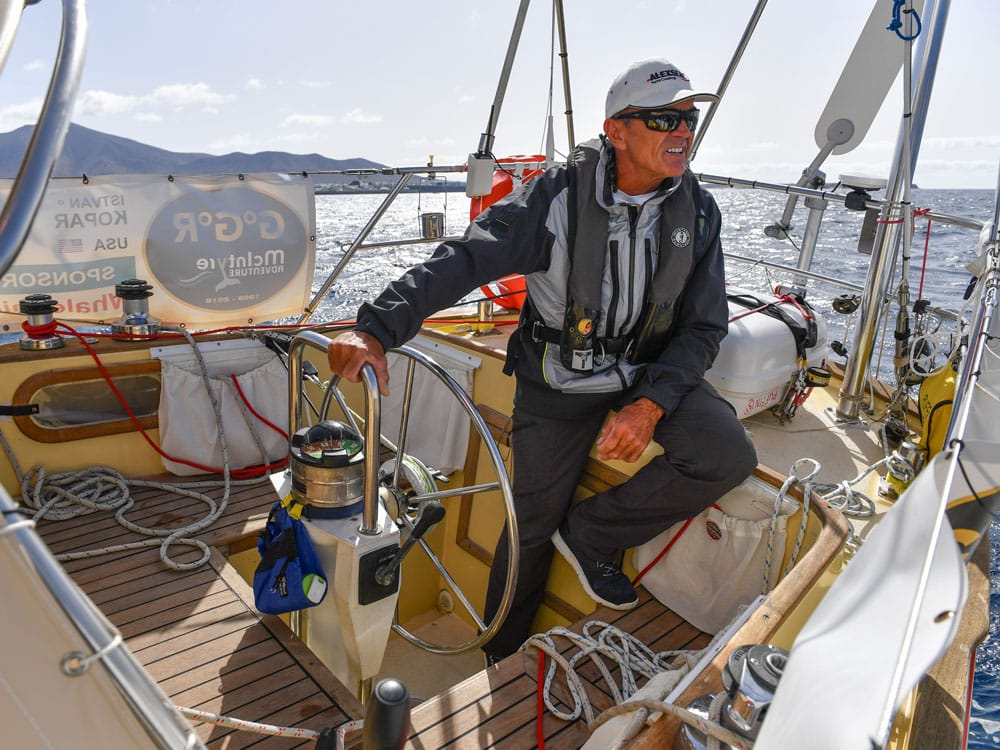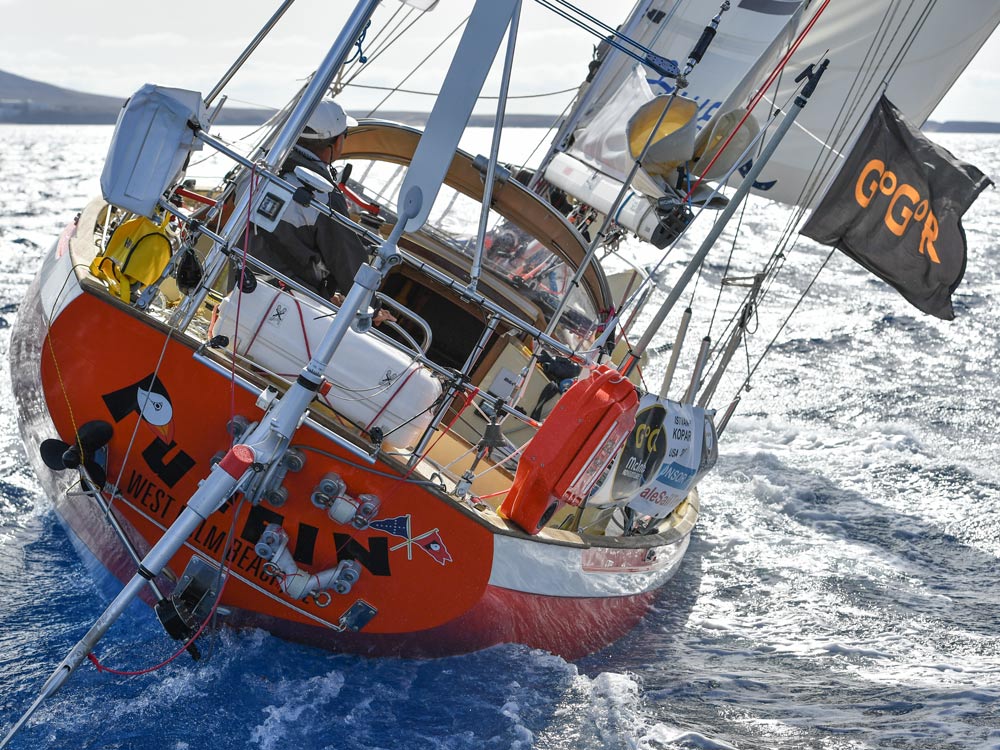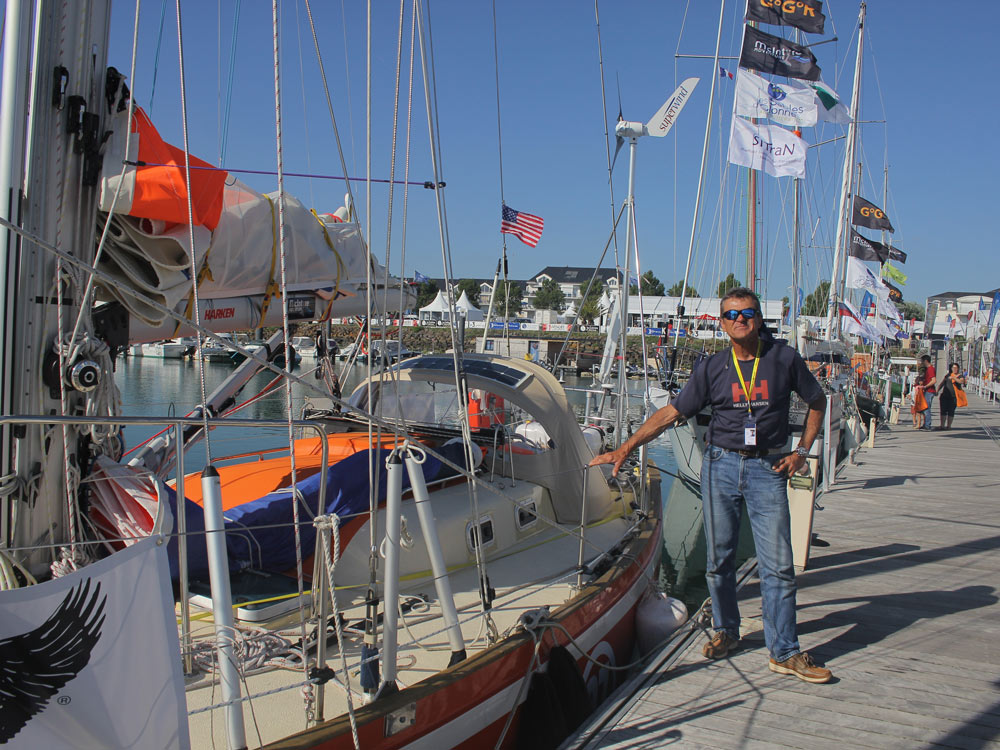
2018 Golden Globe Race – Istvan Kopar (USA) Tradewind 35 Puffin passing through the Marina Rubicon ‘Gate’ off Lanzarote in the Canaries.
It’s bedlam on the docks at the Golden Globe Race Village in Les Sables d’Olonne, France. Storm sails and immersion suits lay strewn along the docks, couriers run up and down the gangway. Support team personnel unpacked boxes, count soup rations, and extract chart plotters and electronic autopilots off the raceboats. All the while, journalists and fans patrol the scene, peppering the racers with questions and asking for autographs. If the skippers look harassed, it’s because they are. One week out from starting a solo non-stop round the world race without any modern technology or outside assistance is stressful enough. Time was not on their side, and nor will it ever be.
Istvan Kopar, the only remaining American-flagged entrant (all other Americans had already dropped out) offers to show me around Puffin, his 1986 Tradewind 35 and home for the next 250 or more days. He greets me with a vigorous handshake and shooed his Hungarian friend (Kopar was born in Budapest) off the boat, sending him to the car with yet another box to be unloaded. Perhaps annoyed at being sent on a make-work mission to create space aboard for a pesky journalist, he mutters something in Hungarian and wanders up the dock.

2018 Golden Globe Race – Istvan Kopar (USA) Tradewind 35 Puffin passing through the Marina Rubicon ‘Gate’ off Lanzarote in the Canaries.
Once on board, our tour begins with a few of Kopar’s favorite items in Puffin‘s inventory: an old ship’s bell from his previous boat and a pair of brass oil lamps affixed to the forward bulkhead. “[I’m] an old-fashioned guy, [so] I have the old-fashioned lamp,” he explains. Though LED lights are one of the few anachronistic items permitted in the Golden Globe Race, Kopar holds himself to a higher standard: adhering to the retro spirit of the race rather than the equipment rules themselves.
The race marks the 50th anniversary of the Golden Globe, a challenge so arduous that only one out of nine boats finished. The winner, Robin Knox-Johnston, became the first person to sail around the world solo non-stop, an achievement for which he was knighted. Another competitor, Frenchman, Bernard Moitessier, on the cusp of winning the prize for fastest-time, ditched the course in the name of “saving [his] soul” and completed a near second circumnavigation. Yet another entrant, British amateur, Donald Crowhurst, set sail in an unsound boat and upon realizing he wouldn’t survive the journey, began falsifying position reports before allegedly committing suicide.
Competitors in the 2018 Golden Globe are equally as colorful. The initial entrants at the time of writing range in age from 26 to 71 and include professional sailors and amateurs, a mountaineer, an oceanographic surveyor, a foreign-exchange trader, and a rower who holds the speed record for an Atlantic crossing. The latter is able to row his 36-foot sailboat in low winds, which he can average 2 knots in a dead calm.

The race’s current edition promises to be as challenging as the first. Competitors are limited to using technology that would have been available on Robin Knox-Johnston’s boat in 1968, meaning no GPS, AIS, radar, modern weather products or routing, computers, and electronic autopilots. None of this phases Kopar, who has already sailed around the world solo without the aid of modern technology.
He points to his ship’s compass, [“This particular compass is a unique piece because it was in my very first solo circumnavigator boat, Salammbo. I sailed 60,000 miles :with this compass: so :it’s: an old friend.” Kopar is referring to his 1990-1991 solo one-stop circumnavigation in his self-built 31-footer, which he did without the conveniences of GPS, autopilot, radar, water-maker, or heating device.
In addition to his solo one-stop circumnavigation, Kopar has amassed 50 or so years at sea, having worked in the merchant marines, as a naval officer, USCG-licensed commercial captain, and sailing instructor. In the 1996-1997 Hong Kong Challenge around the world race, he skippered the winning boat.
Race to the race
“You know what the heck this is here?!” he exclaims, rattling plastic rings on a rack above his chart table “That’s for a shower curtain, right? I just improvised it. I didn’t have money or time to get serious protection for the chart table, so I just put a home depot shower curtain here.”
Kopar shows me another cost-saving effort, “I was planning to replace the glass on all the hatches, but the bu[dget didn’t allow me to do that…because seamanship is anticipation, preparing for the worst… I cut :canvas covers: the same size on the hatches as a backup…It’s a temporary solution but at least I can avoid a sinking situation.”|]
Puffin is full of these little Koparisms: clever low-cost solutions that he’s manufactured over the last two years.
Unlike the $10 to 15 million-dollar Vendée Globe entries, the GGR2018 boats cost a measly $200,000 to 300,000 to purchase and refit. The boats must be full-keeled, production boats between 32 feet and 36 feet overall, and designed before 1980. Kopar, being thrifty, estimates he’s spent a bit more than $100,000 of his own money and more than 2,000-man hours preparing Puffin. The refits were extensive: all new rigging, sails, watertight bulkheads, not to mention his self-termed “granny bars” (a mast pulpit) for securing his body while reefing (one of his few concessions to age — he is 65). He also decreased the size of the cockpit, stripped his boat back to glass, and painted Puffin‘s topsides a bright safety orange.
Though Kopar was able to use many pieces of gear that he’d saved and salvaged over the years, Puffin‘s refits were a financial strain. He and his wife had recently downsized, “Unfortunately the Golden Globe Race took our old home,” Kopar tells me. “This was maybe the biggest sacrifice, especially on behalf of my wife and my family.”
Earlier in the day I’d met Kopar’s wife on the dock, a blond vivacious woman, in a “Team Kopar” T-shirt. The two years of preparation have taken an emotional as well as financial toll. Kopar went months at a time without being able to see his wife, while he worked on the boat in New York. Whenever possible he’d make the grueling 22-hr drive home to Florida. “I started the solo lifestyle pretty early,” he says.
Kopar directs me forward to the head to inspect the compression post. [During the refits, when he replaced the mast, he’d removed the head door. “The race organizer was very stubborn that we had to put :it: back in the boat…which is nonsense for a solo sailor. Why do you need the privacy? But it turns out that this was a life saver for me, because when I put the door back, I couldn’t close it. That was the first time that I noticed that the deck was compressed by the mast… there was a kind of misalignment between the new mast and the compression post.”
A problem that, Kopar agreed, could have been catastrophic in bad weather. Just months earlier, Australian entrant, Shane Freeman, who’d planned to sail from Australia to the starting line in France in another Tradewind 35, had been dismasted shortly before rounding Cape Horn. Fortunately, Kopar was able to offset the load on the deck with a custom stainless-steel fitting, before sailing Puffin across the Atlantic to the start. “There’s always a risk that you don’t physically get to the start line,” he said.
“This is grab bag one,” he indicates pointing to a bag on the port berth. “I am preparing grab bag number two.” I could tell the safety inspections weighed heavily on his mind. The next day, Puffin, will be combed over by two Golden Globe safety inspectors. While the race is retro in spirit and largely in practice, entrants are required to carry a long list of modern safety equipment including EPIRBS, PLBs, and Satellite phones. Items that might provide a competitive advantage (like GPS or an electronic autopilot) are stored in a sealed container. If the seal is broken, the competitor is considered retired from the race. Only when a competitor passes the safety inspection are they issued a “Green Card” and deemed an official entrant.
Every competitor I speak with finds the race safety regulations a real burden. The next afternoon, I run into a frustrated Kopar. The safety inspectors had dinged him for having expired water bottles on board. “Unbelievable!” he tells me, throwing up his hands. Fortunately, he does earn his “Green Card.”
Survival over speed
On deck, Kopar tells me about another recent disagreement he[‘d had with the race committee: “|] Puffin‘s topsides are orange, so… I believe I can skip the [race rule of having] two square meters of orange on the deck. But they were very clear that no way, I cannot have this. So yesterday we did this … butchering, very quick.” He waves his hand at his now tangerine cabin top. “So unfortunately, we made Puffin ugly.”
I tell him I thought it doesn’t look so bad, but he isn’t comforted. If there is any consolation to be had, it’s that the now orange-on-orange Puffin will at least be highly visible. Something that Kopar might eventually appreciate as he’ll be operating without radar or AIS and considers the risk of collision to be one of the greatest hazards in the race.
“There are greater numbers of ships and there are no untouched areas anymore,” he told me, “It’s not like the old days where you had a relatively good idea about the shipping lanes.”
Down below deck, I notice a piece of gear that seems out of place. “Is that a crash helmet?” I ask, pointing at the glossy cherry-red orb stowed just out of sight. “Ya,” he says, “This was not necessarily a [safety] requirement but suggested by many. I got the feeling that it’s better to get home in one piece…. I’m preparing for the worst.”
It seemed a practical precaution, when you consider the seriousness of a head-injury in bad weather, days if not weeks away from help in the Southern Ocean.
To my right is another oddity. “[In case] you need to send a special message to someone by slingshot,” Kopar explains. The slingshot was in fact, not so strange. In the 1968 race, Frenchman Bernard Moitessier, used a slingshot to lob film cannisters and messages at passing ships. While GGR2018 will have HF radios and be able to communicate with ship and shore stations, they will otherwise be entirely alone for more than 250 days.
Forward of the galley is a latched wooden box, firmly affixed to a bulkhead. From it, Kopar, retrieves a plastic sextant; “A sextant is fragile, and you don’t want to damage it before you finish the circle around the globe.” Undoubtedly, one of the great challenges in this race will be navigation. Especially, in the Southern Ocean, where, as Kopar explains, “There are … areas where you cannot have a fix for two weeks because it’s overcast and there is no way to shoot a heavenly body. It’s nerve-wracking to just rely on dead-reckoning.”
Next on the tour, is Kopar’s “secret weapon.” He rummages around under the port settee cushions before triumphantly surfacing, brandishing what looked like a stick of pepperoni. “No one else has this in the fleet,” he exclaims waving the vacuum-packed sausage around proudly, “This is Pemmican… used by old expeditions like Scott and Shackleton and so on. US Wellness meats in Missouri… created this for me… [So, it will hopefully survive] the tropical heat…making it down to the Southern Ocean where I need really rich fat protein. I got a supply for pretty much 2,000 calories per day.”
By my calculation that’s roughly 2,500 individually wrapped sticks of Pemmican.
The tour ends and Kopar presents me with a “Team Kopar” shirt and a copy of his book, Khivas – Alone at the Ends of the Earth. As I walk back up the docks, I notice the frenetic activity has settled into an early-evening hub-bub. The gates have been closed for the day, giving the skippers and their teams a reprieve from the crowds, space to work on boat projects with a beer in hand. I stop by the grocery store where I run into Kopar’s Hungarian friend, who has seemingly now been tasked with grocery shopping. He asks me what the words for “ice cream” and “cold beer” are in French. I smile, knowing Kopar is finding time to enjoy shoreside luxuries before embarking on his 250-day Pemmican fuelled odyssey.
Ed’s note: At press time, on July 23, Kopar had anchored in Sao Vicente, Cape Verde to either replace or repair his problematic self-steering system. Follow his progress on Facebook, or at koparsailing.com or www.goldengloberace.com.









